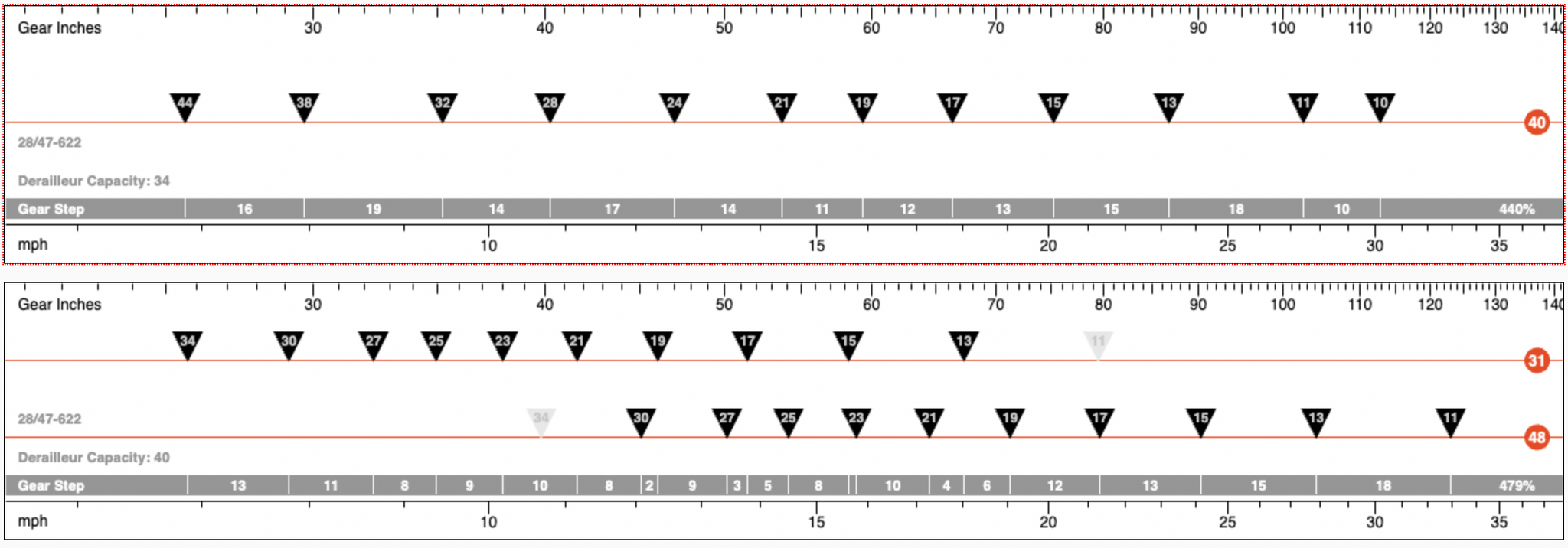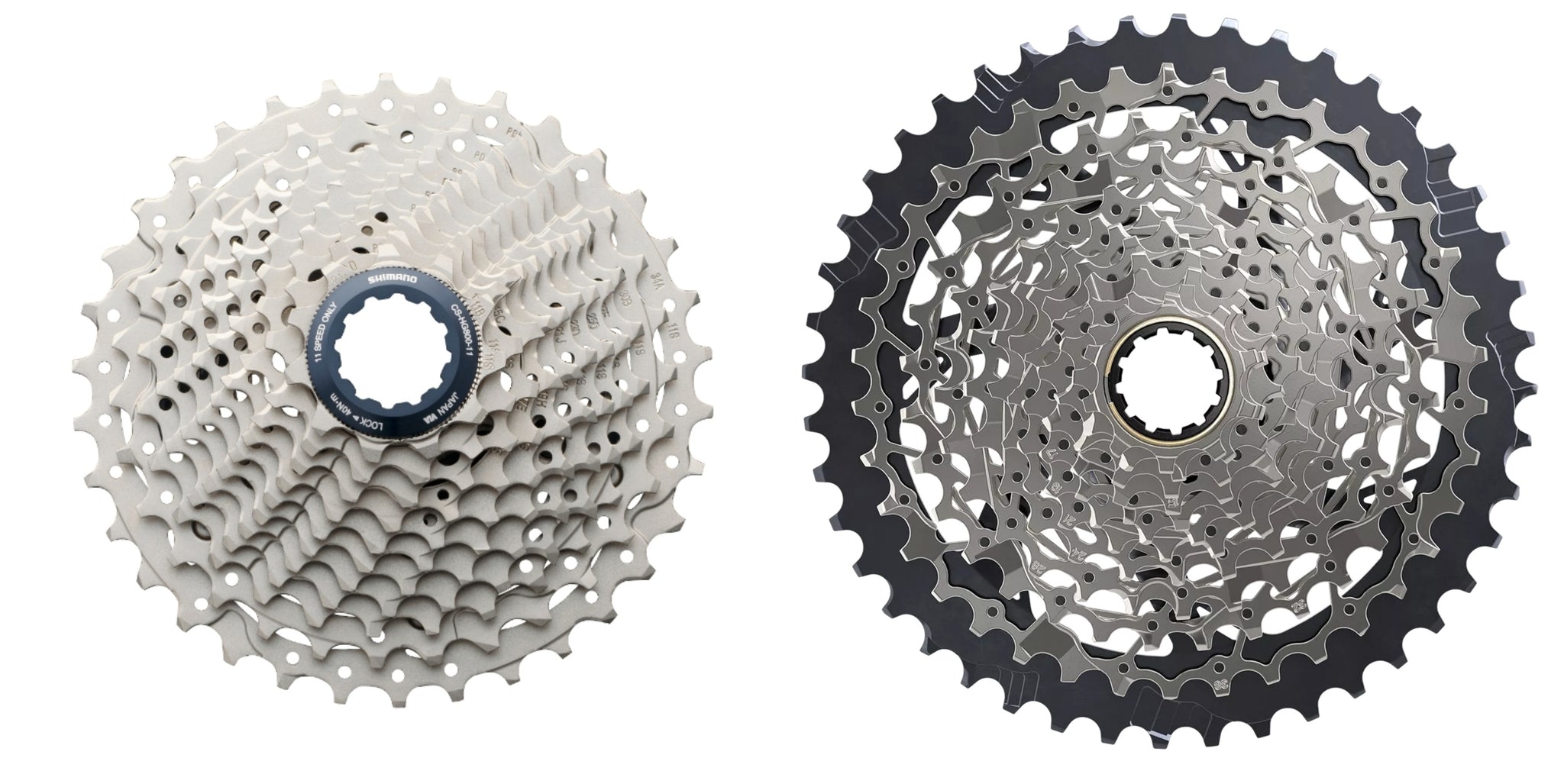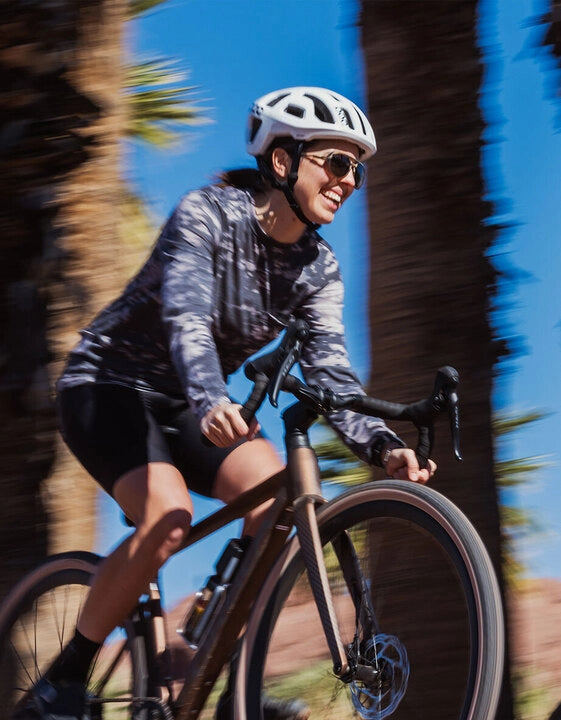1x vs 2x might be the most contentious topic in gravel. People seem to sit on one side of the aisle or the other, and they don’t like to budge. That definitely describes me. I am a diehard 1x rider. I’ve been using a 1x for gravel riding and racing since 2017. Now, I even ride a 1x on my road bike. You will have to pry my narrow-wide chainring from my cold dead hands.
In reality, both drivetrain setups have strengths and weaknesses. With some big goals ahead of me, the thought of switching up my drivetrain this year has crossed my mind. I’ll be going over what drivetrain I’m choosing to race this year at Unbound Gravel and I’ll explain why you might want to choose a 1x or 2x.
[button]Shop Gravel Bikes[/button]
My 2024 Unbound Gravel Drivetrain Is (Still) a 1x
I won’t bury the lede. After a winter of overthinking, agonizing, and window shopping, I’ve decided to stick with a 1x for this year.
I was on the fence and may have been swayed by one of 2x’s biggest benefits (more on that in a bit). Ultimately though, I decided against 2x, and one of the biggest reasons was so I could continue riding my current bike, a 2022 Lauf Seigla, which is designed to be 1x-only, so I can’t run a 2x even if I wanted to.
 The Seigla originally came with a SRAM Force AXS XPLR 1x gravel drivetrain, but last year I switched it to a SRAM 1x “mullet” setup with an Eagle AXS mountain bike derailleur and a 10-50t Eagle Cassette. Originally, I had a fancier XX1 Eagle derailleur, but I destroyed it last year. I decided to “cheap out” with the X01 version when replacing it.
The Seigla originally came with a SRAM Force AXS XPLR 1x gravel drivetrain, but last year I switched it to a SRAM 1x “mullet” setup with an Eagle AXS mountain bike derailleur and a 10-50t Eagle Cassette. Originally, I had a fancier XX1 Eagle derailleur, but I destroyed it last year. I decided to “cheap out” with the X01 version when replacing it.
[newsletter]
2x Has More Recent Wins at Unbound Gravel

Last year's winners. Keegan's 1x (left) and Carolin's 2x (right). Photo: SnowyMountain Photography.
If we keep things super simple and just look at race winners over the last 3 years, 2x drivetrains have actually been more successful than 1x drivetrains:
|
Drivetrain: |
1x |
2x |
|
Unbound wins (since 2021): |
2 |
4 |
2023:
- Keegan Swenson won on a 1x SRAM XX-SL Transmission drivetrain.
- Caroline Schiff won on a 2x Shimano Dura-Ace drivetrain.
2022:
- Ivar Slik won on a 2x Shimano Dura-Ace drivetrain.
- Sofia Gomez Villafane won on a 2x Shimano Dura-Ace drivetrain.
2021:
- Ian Boswell won on a 1x SRAM Red/Eagle XX1 AXS mullet drivetrain similar to mine.
- Lauren de Crecenzo (a former TPC employee!) won on a 2x SRAM Red AXS drivetrain.
So should you ride what the winners ride? Maybe. I often caution regular riders against copying the pros (they're freaks), but it’s hard not to pay attention to what the sport’s peak performers are choosing. Really, I think the results just show that it’s possible to succeed on both 1x and 2x drivetrains, and ultimately, it’s the rider and not the drivetrain that makes the biggest difference.
The Pros and Cons of 1x Drivetrains

|
Pros: |
Cons: |
|
|
[button]Shop Drivetrains[/button]
1x Can Come Close to the Gear Range of 2x
The biggest concern people tend to have with 1x is the gear range. For most riders, a 1:1 granny gear is the bare minimum for surviving climbs. An even easier gear would be even better. If you’re racing (or doing a fast group ride) though, you also need a big enough top gear so that you don’t get spun out chasing fast riders, especially when going downhill.
Personally, the gear range with modern 1x drivetrains has been a non-issue. Most current wide-range 1x cassettes provide enough range, especially 12-speed options that use a smaller 10t cog (instead of 11t).

If we compare the two most popular gravel drivetrain options we currently sell — 12-speed SRAM AXS XPLR and 11-speed Shimano GRX — you’ll see that the overall range is similar with a 40t chainring on a SRAM XPLR setup. You miss out on a bit of top-end, but I don’t think most “normal” riders will notice.

If we compare my current 1x mullet drivetrain with a 44t chainring to a Shimano GRX drivetrain, the results are similar. If I were to use a bigger 10-52t Eagle cassette, I’d have even more low end, which would allow me to potentially run a larger 46t cassette for even more top-end if needed.
Additional Note: What size 1x chainring should you use?
The last three times I’ve gone to Unbound, I ran a 40t chainring. The terrain at Unbound is rolling, and it doesn’t have any long extended climbs, but it does have a lot of short and steep hills and kickers, a few of which are hard enough to force many riders to get off and walk.
With a 10-42t or 10-44t cassette, a 40t was just easy enough for the hardest climbs on the course, and I also didn’t spin out at any point during the race (I was ~3.5 w/kg back then). Even if your smallest cog is an 11t, you have to be going well over 30 mph to spin out a 40t. Unless you’re a pro with a massive engine, that just doesn’t happen that often.
My opinion is that most “normal" 1x riders should be fine with a chainring in the 40-44t range.
The Jumps Between Gears on a 1x Cassette Are Bigger

A 11-34t Shimano 2x cassette is much tighter than a 10-44t SRAM 1x cassette.
With a 2x drivetrain, you can use a cassette that provides more 1- and 2-tooth jumps between cogs while wide-range 1x cassettes tend to use larger (2-8 tooth) jumps to increase gear range. This matters to some riders because when you’re pedaling at high cadences, bigger steps between gears noticeably affect your cadence.
Shifting up or down a single gear on a 1x can sometimes force you to pedal 10-15 rpm faster or slower. That’s a pretty decent jump. If you’re on the rivet, struggling to stick to a fast group, maintaining your ideal cadence could be the difference between staying attached and getting dropped.
Personally, I don’t feel like big gear jumps are a major factor in gravel racing. First, I’ve just gotten used to the bigger jumps and don’t notice them anymore. Second, rough or rolling off-road terrain often forces you to regularly change cadence anyway. I find the bigger jumps on a 1x cassette actually suit changing surfaces and short punchy climbs and descents. Reacting to abrupt changes on a 2x can often require two or more shifts.
If you happen to want a 1x but still care about having smaller steps between gears, Campagnolo’s 13-speed Ekar group could be a solution. It has 1-tooth jumps between the 6 smallest cogs, which is 5 more than SRAM’s current XPLR 1x cassettes.
1x Drivetrains Are Less Efficient Than 2x
Compared to a 2x drivetrain, the chain angle on a 1x drivetrain is more severe at the extremes (the highest and lowest gears) of the cassette. This higher chain angle increases friction between the rollers and plates in the chain, which reduces efficiency. The narrow-wide chainring teeth that 1x drivetrains use for chain retention also create a bit more friction than the traditional teeth found on 2x chainrings.

Independent testing by VeloNews and CeramicSpeed has shown that 1x drivetrains are 1-6 watts less efficient than 2x drivetrains.
Do I actually notice this efficiency loss while riding? Not really. But if you’re the obsessive type, efficiency losses like this are a big deal. In the 1x vs. 2x battle, this efficiency disparity is the one thing that would sway me to use a 2x instead. Because there are two chainrings, 2x drivetrains allow you to keep the chain straighter more often, which reduces friction and improves efficiency.
If you choose to ride a 1x though, frictional losses can be minimized when the chain is in the middle of the cassette where it’s straighter. If you’ve chosen the right size 1x chainring, you spend the vast majority of your riding time in the middle of the cassette anyway.
This is actually why I chose a 44t chainring on my current setup. With the SRAM AXS app, I can see which gears I’m using the most. With a 40t chainring on rolling terrain, I was using the smaller 12t, 14t, and 16t cogs a lot. Upsizing to a 44t kept me in the middle cogs more often.
1x Reliability and Simplicity Outweigh the Cons (for Me)

Training on muddy trails for Unbound in the spring of 2017 convinced me 1x was the right choice for me.
I switched to my first 1x gravel drivetrain in 2017, and over the last 7 years of racing on a 1x drivetrain, I have not dropped a single chain. (I’ve totally jinxed myself now…) Throughout the worst mud of Unbound 2022 and 2023, my 1x drivetrain never had any issues.
With a 2x, however, I have dropped many, many chains. I’ve even broken a chain before with rough a front derailleur shift. Maybe it’s all down to user error, but even so, these negative experiences are what make 1x my preferred option, especially in a race as rough and potentially muddy as Unbound. Without a front derailleur, there’s just less that can go wrong, and spending less time at the side of the road fixing things is a good strategy for success.
Now, this doesn’t mean 1x is infallible. If the mud is sticky enough and you let it gunk up until your chain doesn’t mesh with the chainring anymore, it won’t matter what drivetrain you run. Those are the sections where it’s better to walk (or run). If you let your narrow-wide chainring get super worn, it will also struggle to hold your chain. I always try to swap in a fresh chainring on all my 1x bikes each season before racing starts to maximize chain security.
The biggest benefit for me though is just the overall simplicity. This might sound dumb to people who are used to using a 2x because it’s really not hard to shift a front derailleur. My biggest beef with the front derailleur is just that it’s something extra on my bike.
Never having to worry, think about, or even be aware of the front derailleur existing is freeing. Ditching my front derailleur for my first trip to Unbound back in 2017 was a huge weight off my mind, and that is valuable to me. Mental energy and worry can cost you physical energy and confidence.
These days, I'm used to 1x, especially because I use it on all my other bikes, and I feel really confident and comfortable and even happy when I’m riding a 1x. THAT is the biggest reason I stick with it. You might feel that way about 2x. If so, then that’s a really good reason to stick with 2x instead.
When it comes to drivetrains, I really don’t think there’s a wrong answer. The right drivetrain is simply the one you trust the most and feel the most confident and comfortable using. The mental gain from being confident and comfortable outweighs any actual performance differences.
[button]Shop Drivetrains[/button]
Bonus: Are Di2 and AXS Electronic Drivetrains Worth It?

If there's a chance of rain or mud, I prefer an electronic derailleur.
Confidence and comfort bring me to one last point. I mentioned earlier that Campy Ekar would be a good 1x option if you want close jumps between gears, but there’s one big reason I probably won’t use it: Ekar is mechanical.
I started switching to electronic drivetrains in 2022, and now, I’m a full electronic convert. I’ve put SRAM AXS on all of my bikes because I like using it so much.
Yes, electronic drivetrains are expensive. No, they don’t make you a better or faster rider. I want to be clear, you don’t need an electronic drivetrain to enjoy riding or to race competitively. But holy crap they feel nice to use.
The shifting is so fast and effortless that I’m actually more inclined to shift more often. I love being able to dump gears instantly, especially on rolling and technical terrain, and shifting with a tap of my pinky when I don’t want to let go of the hoods.

Electronic derailleurs these days are super reliable. They stand up well to dirt, dust, mud, and even crashes. When I raced Unbound with a mechanical drivetrain in 2017, I lost the use of a few of my easier gears by the halfway point due to dirt build-up on the cassette. An electronic derailleur, however, doesn’t care what crap is on the cassette. The electric motor just slams the chain into gear.
I also really like how easy SRAM’s wireless AXS derailleurs are to install and pair. I actually plan to take a spare Eagle AXS derailleur (I’m poaching it from my mountain bike) just in case I break my bike again. While it’s probably overkill, having the option to replace a derailleur in minutes, makes a wireless derailleur an easy choice for me.
Final Thoughts
If I were to put money on it, I’d bet on 1x winning the men’s race once again this year. Keegan Swenson still seems unstoppable and he’s sticking with the latest and greatest SRAM Transmission on his bike. On the women’s side, I think it’s about time for a 1x to end the 2x Dura-Ace win streak of the last 3 years. After 2024, I hope to update the win table earlier in this post to an even 4-4.
Anyway, I’m sure there are plenty of 2x and mechanical drivetrain lovers ready to roast me in the comments. Go ahead! I’d love to hear why I’m wrong.
[button]Shop Gravel Bikes[/button]
























